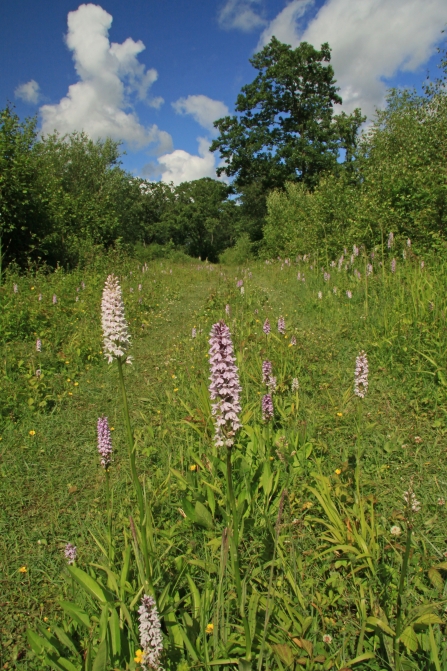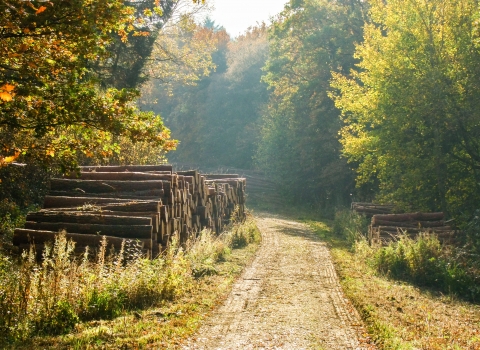Woodland Management
Whilst our woodlands are often ancient landscape features and are relatively stable, they have developed under the influence of humans and woodland wildlife and flora have adapted to our management. Therefore, we actively manage our woods through coppicing, ride widening and other forestry operations to create warm, sunlit micro-habitats that benefit insects and wildflowers and provide better nesting habitat for many of our rarest woodland birds.
Coppicing
Coppicing is the act of cutting down young trees and allowing them to regrow from stumps or ‘stools’. The regrowth is often very vigorous and many coppiced trees live to a greater age than their un-coppiced ‘maiden’ relatives. Many of our woods are historic coppice woods. Here the larger trees have mostly been removed for timber and the wood is very open and dominated by shrubby trees such as hazel, which would have been used for building material or fuel and to make products such as hurdles or other fencing products.
Coppice is usually cut on a short rotation of about seven years. This management creates bare ground in the first two years, allowing in plenty of sunlight and creating a profusion of wildflowers that are excellent for insects such as woodland butterflies like the white admiral and silver-washed fritillary. As the coppice regrowth develops, the previously open coppice plots turn to scrub. The value for insects declines but the plots then provide wonderful nesting habitat for breeding woodland birds such as garden warblers. As the coppice is cut on rotation on our reserves, there are always plots at different stages providing a habitat for a huge range of species.
Unfortunately, with the decline of demand for coppice products, it has become harder to find people willing to exchange the work of clearing it for the product, which means that coppice has become expensive to maintain and the amount now being coppiced across the county is much reduced.
Thinning
Thinning is one of the biggest forestry operations undertaken in our woods. It is the removal of mature trees and is usually undertaken in long-established woodlands to help diversify the size and age of retained trees and to create enough space for them to grow to maturity. This helps to deliver lots of opportunities for different wildlife: big old trees for insects seeking dead wood, young growth for caterpillars and the birds that feed on them and new saplings to create the woodland of the future. Thinning also provides the best chance for the widest range of tree species to establish as it reduces competition from shade-loving species. In this way we can help to ensure that our woodlands are more resistant to change as a result of diseases affecting individual species (including ash dieback and sudden oak decline).
Often we remove a number of trees in a block to allow light to the ground for the benefit of woodland wildflowers. In some areas we actively remove trees to benefit a single retained individual, a process called halo-ing. These retained trees will grow bigger and go on to be the long-lasting ancient trees of the woodland. As they develop fissures and cracks in their bark and areas of dead wood emerge, they offer excellent nesting habitat for a wide range of birds and provide home to a huge range of insects.
Ride management

Woodland Ride CREDIT Wendy Carter
Rides, the name for the networks of open paths through a wood, are effectively linear coppice plots, although they will often be cut every year or over two years. The best rides are wide and sunny and can look like linear meadows, containing beautiful displays of wildflowers awash with insects in summer. Careful management of the edges ensures that rides also provide scrub and small shrubs for birds to nest in and a range of sunny and sheltered places for insects to thrive. As long connected paths, they provide a network through which species can move throughout the wood and further out into the wider countryside.
Forest restoration
When we purchase new sites, it is sometimes necessary to undertake restoration forestry. This is most often the case where a wood has been heavily modified through previous management including, in some cases, complete clearance and replanting with a relatively small number of species. Here the trees will all be the same age and structure, usually tall, thin and densely planted. This creates limited opportunities for wildlife and often very few woodland-specialist species will be present. In cases where the woodland has been planted with non-native coniferous species, we may also face added complications such as a build-up of pine needles that can acidify the soils and further reduce the opportunities for wildlife.
Given the heavy shade created by conifers we cannot simply use small interventions like removing a few trees at a time because these are unlikely to allow for successful colonisation by native wildlife. In cases where woodlands have been planted with conifer trees, therefore, we have to take quite dramatic-looking steps to kick start the return of native plants and animals. We may have to remove up to half the trees in a plot in one felling, with the rest removed later in one or two sessions over several decades as the native trees re-colonise the reserve. Whilst this can appear to be destructive it is in fact the best way to start regeneration of a woodland and promote the development of a native species mix with many of the components found in our more ancient woodlands.
Non Intervention Management

We classify a number of our woodland reserves as ‘non-intervention’, i.e. no work is done there other than managing any paths and keeping boundaries and access routes clear and safe. This is a relatively rare management approach on our reserves, though, and we limit this style of management to those sites for which it is most appropriate, taking into account the wildlife present and size and robustness of the reserves in question.
Non-intervention woodlands are often heavily shaded reserves, where the trees develop a completely closed canopy and allow little light to the ground, resulting in only a limited number of wildflowers on the woodland floor. Where some light does get in, the ground is often dominated by carpets of a handful of species such as bluebell and dog’s mercury. Trees tend to be tall and thin due to the increased competition for light and this makes them vulnerable to storm events, whilst regeneration of new seedlings is rare. More positively, there is often a lot of dead and decaying timber left on the ground, which is excellent for deadwood eating insects.
You might expect non-intervention to be the most ‘natural’ way to look after our woodlands but actually most of the county’s woods have been actively managed for so long – millennia in some cases - that the richness of their wildlife (including many species only found in ancient woodlands) is directly linked to the various forms of management we use. You can find out more about these above.
Winter working
If you're visiting our nature reserves after recent forestry work, the results can look quite drastic in some cases. Often, forestry operations are carried out in the winter months to ensure that we do not harm nesting birds and other sensitive wildlife during the spring, summer and autumn. Winter working does sometimes mean that already wet and muddy parts of a wood get even wetter and more muddy as machinery moves around; this can appear to be very damaging at times. The Trust is mindful of the impacts and takes a positive approach to limiting harm as far as possible. However, it is important to note that woodlands develop slowly over a long time-frame and woodland conservation in particular requires a long-term view rather than being too constrained by short-term aesthetic harm. Carried out with care and attention, even the most drastic works contribute to a much richer woodland for the future.

